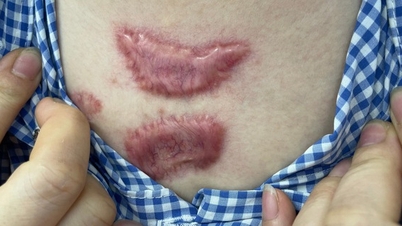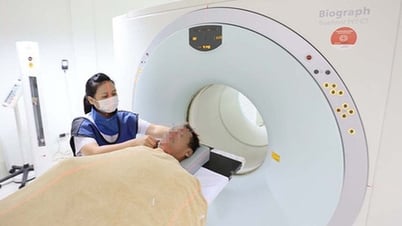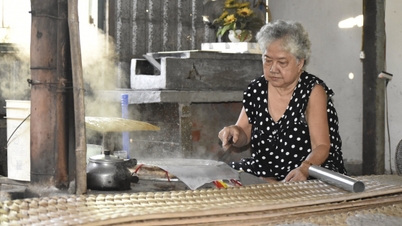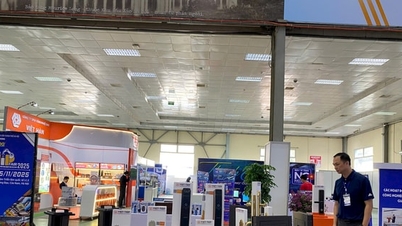Pitted scars are a common consequence of moderate to severe acne, caused by damage to the dermis and collagen remodeling disorders, leading to loss of skin volume. Risk factors for pitted scars include early onset acne, severe inflammation, prolonged treatment, acne squeezing habits and some related genetic factors. Pitted scars seriously affect aesthetics, psychology and quality of life. Currently, there are many methods of treating pitted scars, including chemical peels, scar base separation, microneedling, filler injections, platelet-rich plasma (PRP), stem cells, energy devices such as CO 2 laser, RF waves... Among them, RF microneedle (microneedle radiofrequency) is a prominent method thanks to its ability to effectively improve scars, is minimally invasive and shortens recovery time.

Mechanism of action of microneedle RF
The mechanism of action of microneedling radiofrequency (RF) in the treatment of pitted scars is based on the combination of mechanical damage caused by microneedling and the local heat-generating electrothermal effect. When RF electromagnetic waves are transmitted through microneedles to the dermis or deeper, the generated heat energy will cause changes in the collagen fiber structure, leading to immediate contraction of existing collagen fibers. At the same time, a local inflammatory response is activated, promoting neovascularization and initiating the synthesis of new collagen and elastin, which usually peaks after 3-4 months. In addition, microneedling caused by RF needles also increases the secretion of growth factors such as TGF-β, VEGF and PDGF, contributing to stimulating the reconstruction of damaged skin tissue.
The effectiveness of microneedle RF in treating pitted scars
Microneedling RF is an effective treatment for acne scars, especially for rolling scars and shallow boxcar scars. Improvements are usually noted as early as 1 month after treatment, with a gradual reduction in scar size over time, accompanied by improvements in skin texture and appearance. In addition to its effects on scar tissue, microneedling RF also helps improve associated conditions such as pigmentation disorders, enlarged pores, and acne severity. The electrothermal mechanism not only destroys sebaceous glands and inflammatory papules, but also inhibits comedone formation, promotes wound healing, and thereby reduces the risk of new acne and scars.
Compared to fractional ablative lasers, micro-needle RF has many advantages thanks to its heat generation mechanism through high-frequency currents emitted from micro-needle tips. Heat is precisely transmitted to the dermis without damaging the epidermis, helping to reduce the risk of post-inflammatory hyperpigmentation - a common complication in patients with dark skin types (type III-IV). With the ability to achieve a treatment temperature of 65 - 70°C in the dermis, micro-needle RF stimulates deep tissue regeneration while preserving the skin's surface structure. This method has a low complication rate, is especially safe when applied to sensitive skin areas and at the same time significantly shortens recovery time compared to fractional CO 2 laser.
In terms of clinical tolerance, microneedle RF has a pain level that is rated as mild to moderate, with pain scores in most studies ranging from 1 to 4/10. Common side effects are erythema and mild pain after treatment, while post-inflammatory hyperpigmentation is rare and, if it occurs, tends to regress spontaneously within 3 to 6 months. Another notable advantage is the ability to be safely used on all skin types, including darker skin, making microneedle RF a potential and versatile treatment option in clinical practice, especially when combined with other scar treatments to optimize effectiveness according to each scar morphology.

Combination of microneedle RF and Exosome in the treatment of pitted scars
To optimize the effectiveness of acne scar treatment, micro-needle RF is often combined with other methods such as scar base separation, TCA dots, platelet-rich plasma (PRP) injection, CO₂ laser micro-spots or filler injections. Among these combination strategies, exosomes are attracting increasing attention due to their diverse biological properties and ability to modulate the damaged microenvironment. Micro-needle RF creates controlled micro-injuries in the dermis, thereby opening "biological windows" that allow biological active substances, especially exosomes, to penetrate deeply and exert their optimal effects.
Exosomes are extracellular vesicles containing many biologically active molecules such as RNA, proteins, lipids, amino acids and metabolites. They play an important role in signal transduction, immune regulation and stimulation of tissue regeneration. Exosomes can be derived from animals (stem cells, T cells, dendritic cells...) or from plants (fruits and vegetables such as ginger, grapes, carrots, grapefruit...). Exosomes from plants have the advantages of stability, high immunological safety, simple extraction process and low cost. Meanwhile, exosomes from animals have strong biological potential but are easily degraded and have the risk of activating immune responses.
In the treatment of acne scars, exosomes have been shown to inhibit inflammation, stimulate fibroblast proliferation, collagen synthesis, and promote angiogenesis by releasing growth factors such as TGF-β, PDGF, and VEGF. When combined with microneedle RF, exosomes are most effective in promoting tissue regeneration, improving skin texture, and shortening recovery time.

Post-treatment care
To achieve the best results and avoid unwanted side effects after treatment, patients should avoid wearing makeup until at least the following day to limit the risk of irritation and infection. During the early stages of recovery, prescribed healing agents such as exosomes, platelet-rich plasma (PRP) or growth factors may be used. Patients are advised to avoid direct sunlight and to keep their head elevated during the first 48 hours to reduce swelling.
Home care includes gentle cleansing with a mild cleanser twice daily. Never use any products not prescribed during the early recovery period to avoid complications such as granulomas, irritation or infection. The healing time after the procedure depends on factors such as needle size, depth of penetration and energy level used, but usually ranges from 6 to 12 hours. It is important to maintain a sterile environment in the treated area during this time to ensure safe and effective healing.
Conclude
In conclusion, microneedle RF is an effective and minimally invasive treatment method for acne scars, with a mechanism of action combining mechanical damage and electrothermal effects to help restructure collagen and stimulate skin tissue regeneration. Compared to other methods, microneedle RF not only helps improve skin structure and surface but also reduces the risk of post-inflammatory hyperpigmentation, especially safe for all skin types, including dark skin. When combined with exosomes, this method also brings optimal effectiveness in improving scars, stimulating collagen regeneration and promoting the healing process. Overall, the combination of microneedle RF and exosomes is a promising option, helping to optimize acne scar treatment results, bringing healthy and aesthetic skin.
Source: https://thanhnien.vn/toi-uu-hoa-dieu-tri-seo-ro-bang-rf-vi-kim-va-exosome-18525072509422121.htm





![[Photo] General Secretary To Lam receives Vice President of Luxshare-ICT Group (China)](https://vphoto.vietnam.vn/thumb/1200x675/vietnam/resource/IMAGE/2025/11/15/1763211137119_a1-bnd-7809-8939-jpg.webp)
![[Photo] Prime Minister Pham Minh Chinh meets with representatives of outstanding teachers](https://vphoto.vietnam.vn/thumb/1200x675/vietnam/resource/IMAGE/2025/11/15/1763215934276_dsc-0578-jpg.webp)





































































































Comment (0)